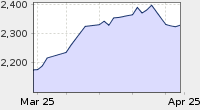For a real-world example of how a system of market-chosen monetary policy would work in the absence of a central bank, one need not look to the past; the example exists in present-day Central America, in the Republic of Panama, a country that has lived without a central bank since its independence, with a very successful and stable macroeconomic environment.
The absence of a central bank in Panama has created a completely market-driven money supply. Panama's market has also chosen the US dollar as its de facto currency. The country must buy or obtain their dollars by producing or exporting real goods or services; it cannot create money out of thin air. In this way, at least, the system is similar to the old gold standard. Annual inflation in the past 20 years has averaged 1% and there have been years with price deflation, as well: 1986, 1989, and 2003.
http://mises.org/story/2533
------------------------
Check out the rest of this blog here.











